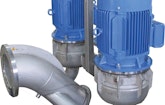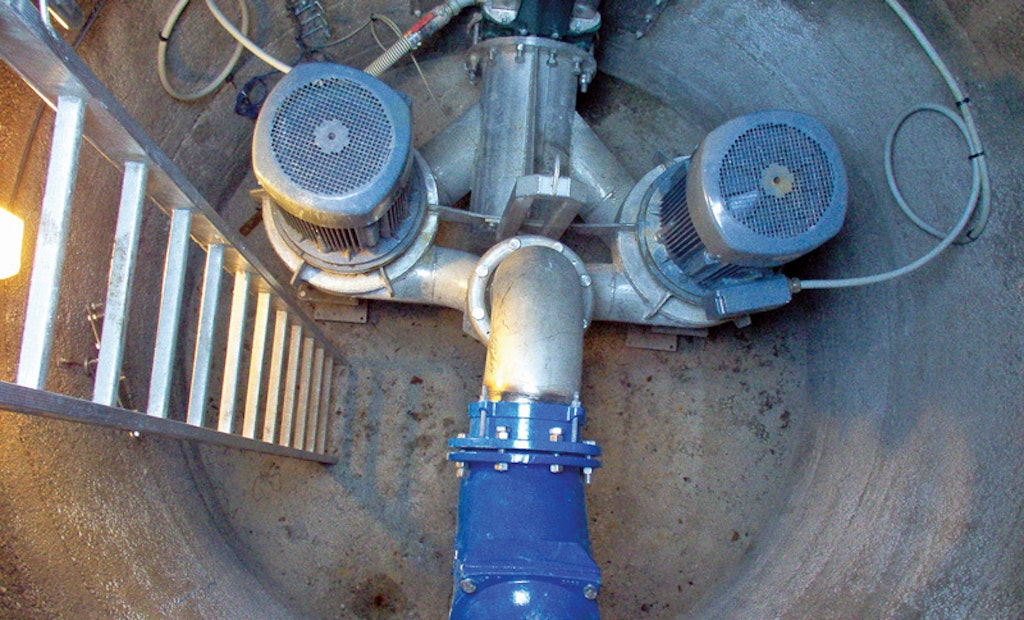Interested in Infrastructure?
Get Infrastructure articles, news and videos right in your inbox! Sign up now.
Infrastructure + Get AlertsLift stations are a key link in the wastewater collections chain. They can also be maintenance-intensive. That’s especially true since the proliferation of consumer wipes products that, when flushed, can collect in lift stations and clog submersible pumps.
Now Kansas-based C&B Equipment offers a different concept in lift station pumping. Called the DIP System (for direct inline pumping), the technology has been deployed in numerous wastewater systems in Europe, but is new to North America.
In place of submersible pumps installed in a wet well and activated by floats, the DIP System pumps are directly connected to the lift station inlet and outlet. The pumps run continuously when there is flow, ramping their speed up and down according to the incoming flow volume. When there is no flow, the pumps stop.
In the process, the pumps grind up wipes and other trash to pass through without causing clogs. Jon Dunham, key accounts manager for C&B Equipment, described the technology in an interview with Municipal Sewer & Water.
MSW: How would you describe the difference between your system and traditional lift station pumping?
Dunham: Traditional lift stations use submersible pumps in a wet well. The pumps are activated by float switches when the water reaches a preset level. The pumps then run at full speed to empty the wet well. In the DIP System, the inflow is piped directly into the pump — a wet well is not necessary. The pumps operate continuously and are controlled by a variable-frequency drive so they run at the speed necessary to handle the flow. It is not batch pumping.
MSW: What sort of maintenance do traditional lift stations require?
Dunham: A primary issue with submersible pumps in wet wells is clogging with wipes and other flushable materials. The float switches are subject to fouling with fats, oils and grease, and may require frequent cleaning to keep them operable. In addition, wet wells occasionally have to be cleaned out, typically with a vacuum truck. Then you have hydrogen sulfide gas that can corrode electrical components, anything made of steel or iron, and even concrete. The cost of maintaining a wet well continues for as long as it is in service.
MSW: Why does the DIP System require less maintenance?
Dunham: The wastewater remains inside the piping and the pump, creating a clean and dry environment. Solid objects such as cans and plastic bottles, and fibrous items such as wipes or bandages, can pass through without clogging the pumps. Whereas wet wells typically use a duplex pumping system, which means two check valves and two plug valves in a valve vault, the DIP System uses only one check valve and one plug valve. There is no valve vault, so the system fits in a smaller footprint. The main system components are stainless steel. With soft starts and stops, there is no water hammer, so you ease the impact on the sewer line and valves downstream.
MSW: How does this system deal with wipes, rags and other trash materials?
Dunham: The pump is self-cleaning and uses a special impeller design. When the torque increases, the pump senses that it is becoming clogged. It then automatically slows down, stops and reverses direction. When it does that, knives on the impeller pop up and slice up any trash. When the pump senses that it is running free again, it slows down, stops and returns to the normal pumping direction. All this happens without operator intervention.
MSW: Can this technology be retrofitted to existing lift station wet wells?
Dunham: It is easy to retrofit. There have been cases where retrofits have been completed in one day. You can take an existing wet well, pull out the old submersible pumps, put this system in, and pipe the inlet and outlet directly into the pumping system.
MSW: How is the rate of pumping controlled?
Dunham: The pumps are controlled by the volume of influent, through the electronic system that is provided. The flow rate is measured by a transducer installed in the lower part of the inlet. The transducer measures the depth of the flow over it, and the output from the transducer determines the speed of the pumps. The system has two pumps and two motors, and is sized so that one pump and motor will handle 100 percent of the expected capacity. In the case of higher inflow, both pumps will kick on, so in effect you have 200 percent of capacity.
MSW: How is the system monitored?
Dunham: The control scheme is fully customer programmable. Users can check on or adjust the pump operation remotely using a smartphone, tablet or desktop computer. They can dial up the pump, see how it’s running. They don’t have to send a crew to the site.
MSW: Where has this technology been deployed successfully?
Dunham: The first system went into use in Europe in 2003, and since then thousands of them have been installed. In Europe, wastewater is typically handled by the private sector under contract with municipalities. These contractors often remove the submersible pumps from lift stations and install the DIP System to eliminate maintenance. From that point they can largely manage the system remotely.
MSW: What return on investment can a utility expect from a retrofit of this system?
Dunham: That depends on the size of the system and the initial cost, but a typical installation will pay for itself in two to three years from the savings on maintenance.
MSW: How does this technology fit the needs of today’s wastewater systems?
Dunham: Every government agency and utility I talk to is looking for innovation and sustainability. This system answers those needs. Furthermore, the wastewater industry is facing a personnel issue with a coming wave of retirements. Our system lends itself to younger people because it’s technologically astute and frees them from dirty work, which no one wants to do anymore.








